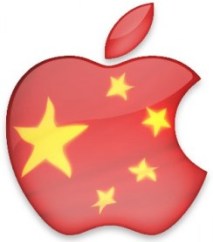Apple today posted Q2 earnings that beat estimates at $43.6 billion in sales, which illustrates that, while the Americas — led by the U.S. — remains the company’s single biggest market, Asia, led by sales in China, continues to show the strongest growth amidst weakened demand at home and in Europe. Overall, international revenues outside of the Americas were $24.3 billion, or 56 percent of the total for the quarter.
International has been and will continue to be a focus for Apple. Cook cited worldwide smartphone figures from IDC that predict shipments of 1.4 billion units annually by 2016; and tablet figures of 375 million units by the same year, according to Gartner. While the U.S. continues to be a strong market for sales today, much of the future growth in mobile devices will be happening in less mature markets outside of the U.S.
On the earnings call earlier, the biggest focus for what is happening internationally was Greater China, a hotly contested market that has been largely dominated by Android device makers. In Greater China this quarter, Apple has had a mixed picture. On the one hand, its revenues of $8.2 billion, sequentially, made Greater China its biggest market in terms of growth, increasing by 20 percent, while all other regions declined in the holiday aftermath. Compared to the same quarter a year ago, however, China was less impressive. It grew by 8 percent, putting it just one percentage higher than the U.S., its slowest-growing market at 7 percent.
Is Apple hitting a wall there? asked one analyst. No, answered CEO Tim Cook, “We had our best quarter ever in China.” In total, he pointed out that including retail store sales, Apple had $8.8 billion in China ($8.2 billion on the PDF posted by Apple, which does not include retail sales). That is up 11 percent year-on-year, Cook said, “the same rate Apple is growing.” He also noted that iPad sales grew by 138 percent with new records getting set for iPhone and iPad sell-through. He also noted that while a year ago, Apple launched the iPhone 4S with two different operators, at two different periods, in the quarter, with the iPhone 5 this time around, the launch fell outside of the 12-week period covered by today’s earnings.
“We still see a very significant opportunity in China,” he said, noting that there are now 11 stores open in the country with plans to double that. Although Apple still does not have a local iTunes store in the country, Cook promises that it is innovating online there and “adding different functionality.”
He also dug in a little on how Apple is tackling the cheap smartphone trend in China. Although the company has long been rumored to be working on a low-cost iPhone for now the company continues to use its older models as its “low cost” devices. He noted that it is selling the iPhone 4 as its low-cost device for first-time buyers. “We are hoping that will help iPhone sales in the future.”
This quarter, Apple faced a tough PR push in China over its warranty policy. The negative comments, which extended into nightly criticisms on national evening television news programs, even prompted an apology from CEO Tim Cook on the company’s Chinese site. That did nothing to help Apple, which is already facing strong price pressure from smartphone makers building locally focused handsets on versions of Google’s Android. At the end of December, it was estimated by analysts at Informa that Android devices were approaching two-thirds of all mobile phones (not just smartphones) sold in the country, compared to just 5 percent for Apple.
In other international regions, Europe continues to be Apple’s second-largest market after the Americas at $9.8 billion in revenues (without retail calculated in). That’s growth of 11 percent over last year but down 21 percent on last quarter, giving it just a $1.6 billion lead ahead of Greater China.
Meanwhile, Japan and the rest of Asia-Pacific saw the very strongest growth, but the proportion of sales in those two regions continues to be relatively small. They were up respectively at 19 percent and 26 percent over the same quarter last year, working out to around $3.1 billion in each of those markets. Adding that together with Greater China, it has yet to outweigh the combination of Europe and the Americas, but is definitely bigger than either one taken on its own.
































Comment